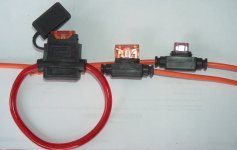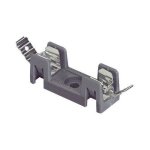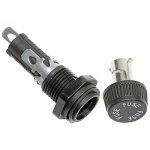kje
100 W
I used 16awg wires.
How can I limit/adjust the amps?
How can I limit/adjust the amps?


I would not blame the AGC fuseDrkAngel said:I mentioned previously that glass tube fuses-holders weren't holding up too well. (40A)
Well ...



Turbo Switch ThreadDrkAngel said:2 x 7s 25.9V 25.92Ah batteries, several thousand miles on each, are really perking up with the warm weather!
Runs my comfort cruiser 24V eZip LS at ~20mph and my pedal assist 24V eZip at 21mph+ (motor only)
Also helps that tires don't go soft after sitting in the cold.
2015 "Eco Ride", oem gearing, cruises at 17mph+!
For economy and battery longevity I intend on "retiring" one of my 25.9V 25.92Ah packs, dedicated for its use.
2008 iZip Mountain Trailz will receive other.
Building 2 more 7s 25.9V 25.92Ah packs, from cells I tested for unrealized eMotorcycle build.
Will also build a 3s 11.1V 60.48Ah or 51.84Ah w/inverter pack for a dedicated Turbo.
EZips have a 3 position (on\off\on) 2 pack switch.
With a simple rewire, switch can run 7s 25.9V pack (485w motor output) in position 1. - 20mph
Position 2 runs 7s and 3s pack in series for 10s 37V (~695w motor output) - 27mph (30mph w\moderate pedal assist)
If you are wiring up a BMS, all you need is a CC/CV power supply or charger, with the appropriate voltage and Max current output. Options would include the Grin Satiator, or Mean Well PS, or a Kingpan charger.Geekineer said:Noob - here -read lots posts but one lingering question.
Building 10S4P pack with Samsung 3E cells (about 3200mah/cell)
Ordered BMS/PCM from BesTechcPower model HCX-D132, rated 10A cont charge, 30A cont discharge.
??? is:
Do I need a charger with balancing leads connected to each cell with this BMS (which I think has balancing)
or just a constant current, 5A, 42V charger i.e. SuPower???
Can someone chime in and/or recommend a charger for above setup.
Much appreciated
Solarpower said:Got a stupid question here.. Easiest way to test 36V homemade battery pack with no ebike available? 3 12V bulbs in series? No problem with full voltage of 42V?
Allex said:Not home made but a question about P groups.
This is a 15s6p config
Why did they connect all 6 cells on the B- but the rest, like B5 are not connected, I can only see small resistors making the P connection.
If I would want to do a capacity test of each P group I would need connect all those 6 cells together some how. Looks like a PITA.
Or just long steel wire. Stainless for more resistivity ~50x less than copper.Solarpower said:Got a stupid question here.. Easiest way to test 36V homemade battery pack with no ebike available? 3 12V bulbs in series? No problem with full voltage of 42V?
Will these fuses work with 100V DC?:
https://cache.osta.ee/iv2/auctions/1_9_30576207.jpg
0,5$ each
